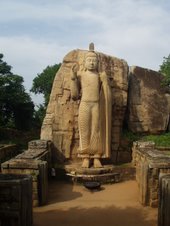Galle is an unusual Sri Lankan city in that it is very relaxing and laid-back. Galle is Sri Lanka's fourth largest city, and was historically a major trading port. The fort area, built by the Dutch, is a UNESCO world heritage site and extremely beautiful. The fort itself is like a different world - very relaxed in comparison to the rest of Sri Lanka (especially Colombo). The fort area is populated by various craft shops, some tacky museums, but mostly exquisite Colonial architecture. Most of the hotels in Galle seem to be owned by sudhas and many of the shops are as well. One craft shop we went to was owned by a French women who was married to a local. Their child was striking to say the least. The 'Galle Fort Hotel', probably the most upmarket and swanky in Galle, was owned by an Australian. We went to their resteraunt for dinner (expensive, but luxurious), and Kumudu was confused by him as someone called 'Sally' and greeted her as an old friend! He also owned two purebred dogs that entertained dinner guests and yapped vigourously.
Kumudu and I stayed at the 'Sun House' on Upper Dickson Road. The hotel is a renovated spice merchant house, built in the mid 1800's. Consequently, it was quite special and was secluded away from the rest of Galle. It was a highly authentic, relaxing and atmospheric place, that had a lounge so that we could mingle with other guests (there were only 6 rooms in total). We chatted with an older couple who had come from England. He was a retired textile lecturer, cum lay clergyman, cum justice of the peace, who was dyslexic (all this in one short conversation). His wife was quite absent from the conversation. Needless to say, a strange couple.
'Sun House' room and Kumudu:
The 'Sun House' exterior:
The 'Sun House' pool and garden:
The fort area is a large medieval-like fortification jutting out into the water. We took a stroll along the wall which was quite relaxing. Regretably, there were an implausible number of touts, fixers and low-lifes hanging around ready to acost hapless tourists. Even more problematicaly, they were even more persistant than your average tout and simply wouldn't go away unless they given a stern talking to. Some boys were asking tourists to pay them so they could watch them jump into the water far below the ramparts (which they duly did regardless of payment). Nonetheless, the whole place was picturesque.
Lightouse in the Galle fort area:

Image of the Galle fortifications:

A typical street in the fort area:

We also visited a beach only 4 kilometres away called Unawatene. Unawatene is probably the nicest beach I've been to in Sri Lanka, it has that Bahamas-esque quality to it: short beach, deep transparent water, coral reef, etc. The food was also amazing and the town itself was quite off the beaten track so it wasn't overcrowded. The coral, regretably, is dying, and this is evidenced by the copious amounts of broken coral washing up on shore. The reason, as always, is entirely human in origin.
Unawatene beach:

Kumudu and I at seaside resteraunt:

Unawatene beach:

The whole trip was great fun. However, our driver 'Bertie' was an interesting case. We paid him to take us to Galle and back over two days - he was good for 300 km (basically Galle and back plus extra driving around). When we arrived at the Sun House, however, he discovered that there was no room where he could stay. This later turned out to be a problem since he asked us to pay for his room. It wasn't much, but one is always left wondering: is this legitimate or am I being played by this guy? It is certainly out of the ordinary for drivers to bother their employers about living arrangements (usually they just sleep in their van if a guesthouse doesn't provide a room), so the whole thing was suspcious. In the end, we just paid him the money - rather grudgingly - but mainly because it was easier.
















